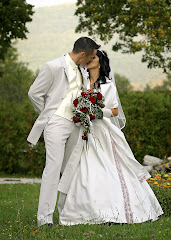
Like many women, after you've accepted your finance's marriage proposal and your thoughts turn to the practical aspects of the wedding that is to follow, what is the first thing you think of? The wedding dress. The Wedding Dress is a symbol, offering an unforgettable lesson in hope, written with the natural simplicity and beauty of a born storyteller. Saying, “I believe in my future, I believe in the man whom I am giving myself to, I believe I have not kept myself in vain, but in the hope of life and success with my husband and the children we will bring forth.”
A Bride's Honor
It doesn't have to be only Cinderella that's adorned in a beautiful gown! If you are soon to be a bride, then the dream of your heart, that you will stand forth in beauty with every eye beholding you doesn't need only to be a dream, but of all rights should be brought forth into a reality that in your memory you can treasure for your life time. The honor bestowed on a bride is not a new thing. To honor a bride is a quality that has been developed among God fearing people for thousands of years who have realized the limitless value that the bride holds for the groom, and the promise of life and family. These facts, although significant as they are do not speaking of a still greater reality, that being, that the bride is meant by God to be an illustration of the Bride of Christ.
Tid-bits from societies around the world
Color, style and ceremonial importance of the gown can depend on the religion and culture of the wedding participants. The styles and colors of wedding dresses have varied according to the fashions of the time, and the circumstances of the wedding. The wedding dress in several Middle Eastern and Eastern European cultures was highly elaborate, and regarded as a means of displaying the bride’s dowry. The color blue has been connected to purity. Many wedding dresses in China are colored red, the traditional color of good luck. In northern parts of India the traditional color of women's wedding garments is red, a color symbolizing auspiciousness. South Indian weddings traditionally use white or cream colored saris. Green is an unfortunate color because of its associations with fairies, and its wearing is also said to fore-tell a change into clothes of mourning. Purple is out because it is seen as a mourning color, one favored by widows from their second year of bereavement onward. In modern western societies almost anything passes for a wedding dress however, in times of old, traditional wedding dresses were flowing gowns usually white in color.
Semi-ancient Biblical Influence
I suggest to you that there is a far deeper and more meaningful understanding of the color of a bride's gown than luck, or to speak of one's cultural, or financial standing. The major influence of wedding gowns being primarily white has sprung forth from two sources that are at least as old as the New Testament writings—One: that white represents the purity and innocence of a virgin woman. In fact, in Godey’s Lady’s Book, 1849, this statement was printed: “Custom has decided, from the earliest ages, that white is the most fitting hue, whatever may be the material. It is an emblem of the purity and innocence of girlhood, and the unsullied heart she now yields to her chosen one.” Beyond these considerations the writings of the New Testament Bible have influenced societies, suggesting that the Bride of Christ, (a metaphorical term used to identify that chosen group of believers who will be deemed a fitting eternal partner to the Lord Jesus) is to be dressed in white. The color white testifying of the righteousness of the saints. Therefore, among God fearing people though the generations it has been their aim to copy this pattern when they have given their daughters in marriage. The question may be asked by a bride to be, “If I have not kept myself pure in the past, but have now confessed my sin, and have turned to God, can I still be married in white?” The answer is most certainly yes. For the blood of Jesus covers all sin. Therefore, all that are found in Him are white and pure in His eyes irrespective of what their past's have been.
Semi-Modern Western Influences
The Victorian era wisely placed a heavy emphasis on feminine purity and chastity, and since white represented these attributes, it was considered a most suitable color for a bride. The reality that the practices and affairs of leading people in society can have tremendous influence on cultures is seen in the marriage of Queen Victoria to her cousin Albert of Saxe-Coburg in 1840. It likely having more influence on weddings than any other modern event. Queen Victoria put the wheels in motion by marrying in white. Though brides continued to wed in gowns of different colors, this single event has been seen to set the modern western standard of white being seen as the color of choice for weddings.
The Industrial Revolution also brought about change. By the 1890’s and the arrival of the department store, almost every woman could realize her dream of being married in a “new” wedding dress. When the Depression hit, brides made do with their “best” dress for the wedding. Because of economic restraints many brides were known to have dyed their white wedding dress a different color after the wedding. Thus making it suitable for everyday use. During WWII, women considered it their duty to give up the elaborations of the traditional wedding, many times opting for quick and easy impromptu services before their husband was taken off by the military. After the World War economic times changed offering to women the cash needed to again experience more elaborate ceremonies.







No comments:
Post a Comment